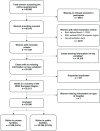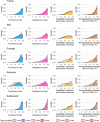Rates of instrumental vaginal birth and cesarean and quality of maternal and newborn health care in private versus public facilities: Results of the IMAgiNE EURO study in 16 countries
- PMID: 36530007
- PMCID: PMC10108180
- DOI: 10.1002/ijgo.14458
Rates of instrumental vaginal birth and cesarean and quality of maternal and newborn health care in private versus public facilities: Results of the IMAgiNE EURO study in 16 countries
Abstract
Objective: To explore the quality of maternal and newborn care (QMNC) during the COVID-19 pandemic by facility type among 16 European countries, comparing rates of instrumental vaginal birth and cesarean.
Methods: Women who gave birth in the WHO European Region from March 1, 2020, to February 7, 2022, answered a validated online questionnaire. Rates of instrumental birth, instrumental vaginal birth, and cesarean, and a QMNC index were calculated for births in public versus private facilities.
Results: Responses from 25 206 participants were analyzed. Women giving birth in private compared with public facilities reported significantly more frequent total cesarean (32.5% vs 19.0%; aOR 1.70; 95% CI 1.52-1.90), elective cesarean (17.3% vs 7.8%; aOR 1.90; 95% CI 1.65-2.19), and emergency cesarean before labor (7.4% vs 3.9%; aOR 1.39; 95% CI 1.14-1.70) (P < 0.001 for all comparisons), with analyses by country confirming these results. QMNC index results were heterogeneous across countries and regions in the same country and were largely affected by geographical distribution of regions rather than by type of facility alone.
Conclusion: The study confirms that births in private facilities have higher odds of cesarean. It also suggests that QMNC should be closely monitored in all facilities to achieve high-quality care, independent of facility type or geographical distribution.
Gov identifier: NCT04847336.
Keywords: COVID-19; IMAgiNE EURO; WHO standards; maternal; newborn; private; public; quality of care; respectful maternity care.
© 2022 The Authors. International Journal of Gynecology & Obstetrics published by John Wiley & Sons Ltd on behalf of International Federation of Gynecology and Obstetrics.
Conflict of interest statement
RC was supported by the Social European Fund and Foundation for Science and Technology under a Post‐Doctoral Grant (SFRH/BPD/117597/2016). EPIUnit (UIDB/04750/2020), ITR (LA/P/0064/2020), and HEI‐LAB (UIDB/05380/2020) are financed by the Portuguese Ministry of Science, Technology and Higher Education. Other authors have no conflicts of interest to declare.
Figures



References
-
- Saltman RB. Melting public‐private boundaries in European health systems. Eur J Public Health. 2003;13:24‐29. - PubMed
-
- Rechel B, Richardson E, McKee M. Trends in health systems in the former Soviet countries. 2014. https://www.euro.who.int/__data/assets/pdf_file/0019/261271/Trends‐in‐he.... Accessed September 29, 2021. - PubMed
Publication types
MeSH terms
Associated data
Grants and funding
LinkOut - more resources
Full Text Sources
Medical

